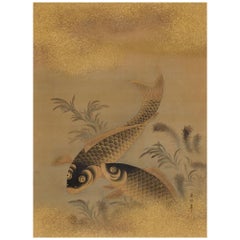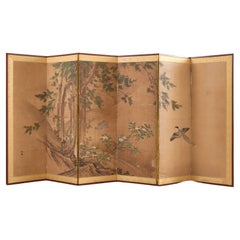Iwase Hirotaka Paintings
1808-1877
Iwase Hirotaka was originally a Kyoto based Ukiyo-e artist known as Hishikawa Kiyoharu. At the age of 26 or 27, he moved to Wakayama, changed his name, and began studying Yamato-e with Tanaka Totsugen and Ukita Ikkei. Totsugen and Ikkei were leaders of the Fukko Yamato-e school and were connected to a political movement that sought to revive the power of the Emperor. A diverse and accomplished artist, Hirotaka eventually turned to literati painting, which he learned from Tetsuo Somon.
to
1
Height
to
Width
to
1
1
1
1
1
1
1
1
1
1
107
80
49
46
Creator: Iwase Hirotaka
Japanese Painting, Hanging Scroll, Mid 19th Century, Koi and Water Plants
By Iwase Hirotaka
Located in Kyoto, JP
Iwase Hirotaka (1808-1877)
Koi and Water Plants
Hanging scroll, ink, color, gold wash and gold flecks on silk
Inscription: Hirotaka
Seal: Ille...
Category
1860s Japanese Edo Antique Iwase Hirotaka Paintings
Materials
Silk
Related Items
Chinese Patriarch and Matriarch Ancestral Scroll Painting
Located in Rio Vista, CA
Magnificent Chinese scroll ancestor painting showing patriarch and matriarch of a high ranking status civil official. This unusual scroll depicts the dignitary couple seated below a ...
Category
Early 20th Century Chinese Qing Iwase Hirotaka Paintings
Materials
Paper, Wood, Paint
$2,640 Sale Price
44% Off
H 76 in W 48 in D 1 in
19th Century Japanese Edo Six Panel Kano School Landscape Screen
Located in Rio Vista, CA
Late Edo period 19th century Japanese six-panel landscape screen featuring a cypress tree over a flowering hibiscus with a pair of hototogisu birds. Kano school painted with ink and ...
Category
19th Century Japanese Edo Antique Iwase Hirotaka Paintings
Materials
Silk, Wood, Paper
Chinese Hanging Scroll of Prunus Branches, circa 1850
Located in Chicago, IL
Chinese scholars used natural imagery and scenery to aid in contemplation within the walls of their studios. The complex beauty inherent to landscapes and natural forms inspired clea...
Category
Mid-19th Century Chinese Qing Antique Iwase Hirotaka Paintings
Materials
Paper
Chinese Hanging Scroll Painting of Camellias Signed Dated
Located in Rio Vista, CA
Seasonal autumn Chinese hanging scroll painting depicting colorful Camellias with a calligraphy signature and date. Crafted on hand-made mulberry paper wi...
Category
20th Century Chinese Qing Iwase Hirotaka Paintings
Materials
Wood, Paper
Japanese Silk Scroll Painting of Moneys Edo Period Mori Tetsuzan
Located in Atlanta, GA
A Japanese mounted vertical hanging scroll painting by Mori Tetsuzan (Japanese, 1775-1841) circa 19th century Edo period. The watercolor and ink on silk ...
Category
19th Century Japanese Japonisme Antique Iwase Hirotaka Paintings
Materials
Silk, Paper
Japanese Six Panel Screen with Hotei, Edo Period, Early 19th Century
Located in Austin, TX
A delightful Japanese six panel painted paper screen featuring the beloved figure Hotei, Edo Period, early 19th century.
Hotei, called Budai in China, and known as the Laughing Buddha or Fat Buddha in the West, is considered to be an emanation of Maitreya, the Buddha of the Future.
In Japan, he also holds a special place as one of the Seven Lucky Gods, being the god of fortune, and protector of children.
He is always portrayed as a mirthful and corpulent man, dressed in loose robes that show off his round belly. He carries a sack with him, said to be filled with treasure. As the protector of children, he is often portrayed with them playing on or around him, as he is here. The children portrayed in this screen are dressed in Chinese style clothing...
Category
Early 19th Century Japanese Edo Antique Iwase Hirotaka Paintings
Materials
Silk, Paper
$6,500
H 54.5 in W 111 in D 0.75 in
Early 19th Century Japanese Six-Panel Screen, Tropical Garden
Located in Hudson, NY
With a banana leaf palm on the left, at water's edge with geese. Perhaps a scene from the southern islands. Mineral pigments on mulberry paper with gold leaf and a silk brocade border.
Category
Early 19th Century Japanese Antique Iwase Hirotaka Paintings
Materials
Gold Leaf
Japanese Meiji Riverside Scroll Painting, c. 1900
Located in Chicago, IL
Although western painting was initially embraced during Japan’s Meiji period (1868-1912), artists brought on a revival of traditional painting styles as they sought to create a modern Japanese style with roots in the past. This exquisite hanging scroll demonstrates the preference for soft layering of gray tones with judicious use of color. The landscape is rendered in soft ink washes that subtly distinguish between water, mountain, and sky. The scroll painting...
Category
Early 20th Century Japanese Meiji Iwase Hirotaka Paintings
Materials
Paper
Large Framed Indian 19th Century Painting of Guanyin Sitting on a Dragon
Located in Yonkers, NY
An antique Indian painting from the 19th century depicting Guanyin the Bodhisattva of Compassion sitting on a dragon. Created in India during the 19th century, this large painting features Guanyin the Bodhisattva of Compassion, sitting on the head of a dragon, fluffy clouds adorning the painting's lower section. Her right foot on a lotus flower, Guanyin wears an ornate headdress and elegant clothes. The painting itself measures 30.5"W x 53.5" H and has been set inside a custom frame. Its peaceful subject will make this 19th century Indian painting...
Category
19th Century Indian Antique Iwase Hirotaka Paintings
Materials
Fabric, Plexiglass, Paper
$4,500
H 61.5 in W 36.25 in D 1.75 in
Chinese Qing Dynasty 19th Century Official's Wife Painting on Linen Canvas
Located in Yonkers, NY
A Chinese Qing Dynasty period framed painting from the 19th century of an official's wife with bird-adorned buzi, painted on a linen canvas. Created in the North-Eastern province of Shanxi during the Qing dynasty, this 19th century painting showcases a frontal depiction of an official's wife recognizable thanks to the bird-themed rank badge sitting on an elegant armchair with scrolling arms and carved apron. Wearing a red robe and topped with an ornate headdress, the figure is highlighted with gold foil accents and stands out beautifully on a linen canvas. The print size is 17.5"W x 41.5"H. These paintings traditionally come from Shanxi province which was home to many of the wealthy merchant families associated with the imperial court during the Qing dynasty. Set inside a custom made frame, this 19th century Qing Dynasty official's wife painting...
Category
19th Century Chinese Antique Iwase Hirotaka Paintings
Materials
Canvas, Plexiglass, Wood
$3,500
H 53 in W 29.25 in D 1 in
Large Framed Indian 19th Century Painting of Guanyin Sitting on a Dragon
Located in Yonkers, NY
An antique Indian painting from the 19th century depicting Guanyin the Bodhisattva of Compassion sitting on a dragon. Created in India during the 19th century, this large painting features Guanyin the Bodhisattva of Compassion, sitting on the head of a dragon. Her right foot on a lotus flower, Guanyin wears an ornate headdress and elegant clothes. The painting itself measures 27.5"W x 53.5" H and has been set inside a custom frame. With its vivid colors and elegant subject, this 19th century Indian painting...
Category
19th Century Indian Antique Iwase Hirotaka Paintings
Materials
Fabric, Plexiglass, Paper
$4,000
H 66.25 in W 35.25 in D 2 in
Set of Four Japanese Silk Hanging Scrolls Screens C.1920
Located in London, GB
A stunning set of four Japanese silk mounted vertical hanging scrolls.
Dating from C.1920 Taisho Period.
The watercolour and ink on silk depicts a larg...
Category
1920s Japanese Japonisme Vintage Iwase Hirotaka Paintings
Materials
Silk
$6,038 Sale Price / set
20% Off
H 83.27 in W 70.08 in D 0.04 in
Iwase Hirotaka paintings for sale on 1stDibs.
Iwase Hirotaka paintings are available for sale on 1stDibs. These distinctive items are frequently made of silk and are designed with extraordinary care. There are many options to choose from in our collection of Iwase Hirotaka paintings, although brown editions of this piece are particularly popular. Prices for Iwase Hirotaka paintings can differ depending upon size, time period and other attributes — on 1stDibs, these items begin at $6,500 and can go as high as $6,500, while a piece like these, on average, fetch $6,500.


